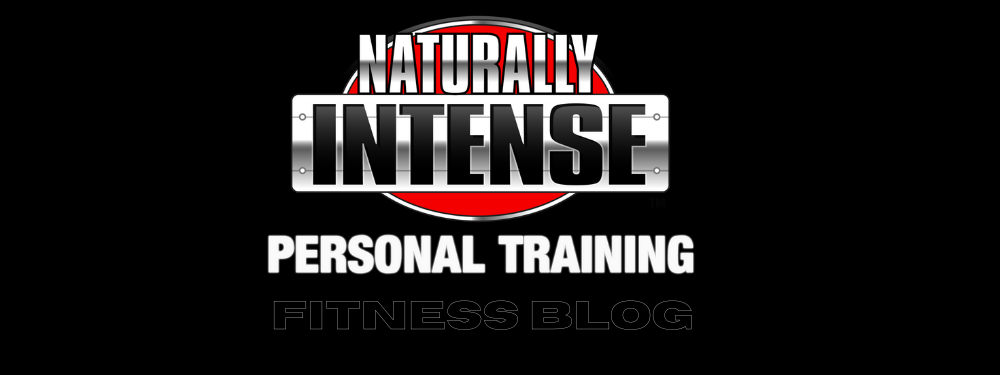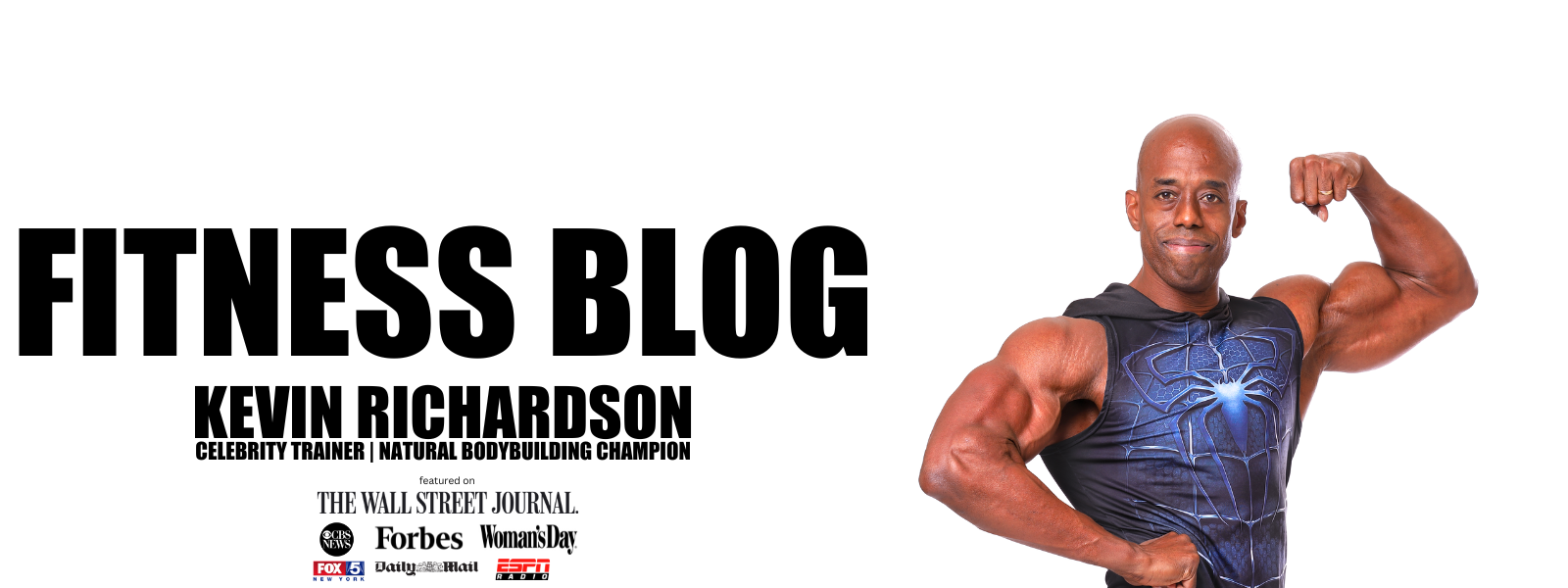
What Happens When You Stop Training With Weights (Updated 6-2020)
The question of what happens when you stop training is a very relevant one being asked a lot during the COVID-19 lockdowns. Here in New York City the gyms closed in March and as of the time of updating this article they were closed for three months and it might be another month before they reopen. While we were able to take our personal training services online and supply our clients with weights, many are not that fortunate, as the increased demand and scarcity of training equipment leads many to wonder what will become of their hard sought gains with such a prolonged period of inactivity. The good news is that what happens when you stop training with weights is a not as awful as you might think it to be. Detraining, or what happens to your body when you stop training, isn’t the end of the world, and you would be surprised to learn that there can be benefits from stopping training! The typical detraining scenario when someone stops working out with weights is as such: You’ve been working out religiously for months or even years on end, making some decent gains in strength, endurance and muscle mass in the process. You’ve found your groove, so to speak and you look forward to your workouts as an integral part of your regular routine. It feels good and you are looking good— and then it happens. You stop or are stopped. For whatever period of time, be it a week, a month or a year and for whatever reason, stay-at-home-orders, a vacation, injury, increased workload or just not enough hours in the day— you have to suspend your gym going. Not being able to make it in to the gym after developing a bit of a routine is an unenviable place where you can immediately feel like all the hard work you put in was for nothing. Your mind starts playing tricks on you as with every passing day you can almost sense that you are getting weaker, you feel your hard earned lean muscle mass melting away and you might feel that your body fat is increasing as well, transforming into a less fit and more fat version of what you used to be. A perfect recipe for depression and whether you are a weekend warrior or professional physique competitor, we can all sometimes feel this way. Thankfully, with short periods away from the gym you don’t lose as much as you think you do— in fact in some cases where you are away for a week or so you can actually get stronger! For longer breaks it isn’t all doom and gloom either. Muscle won’t ever turn into fat— unless you know an exceptionally talented witch doctor— and in this article we will take a look at the timeline of what really happens to your muscles and strength levels when you take a break. Thanks as always for reading and do be sure to share this article with anyone you think might benefit from reading it!
What Happens When You Stop Training– A Week By Week Overview
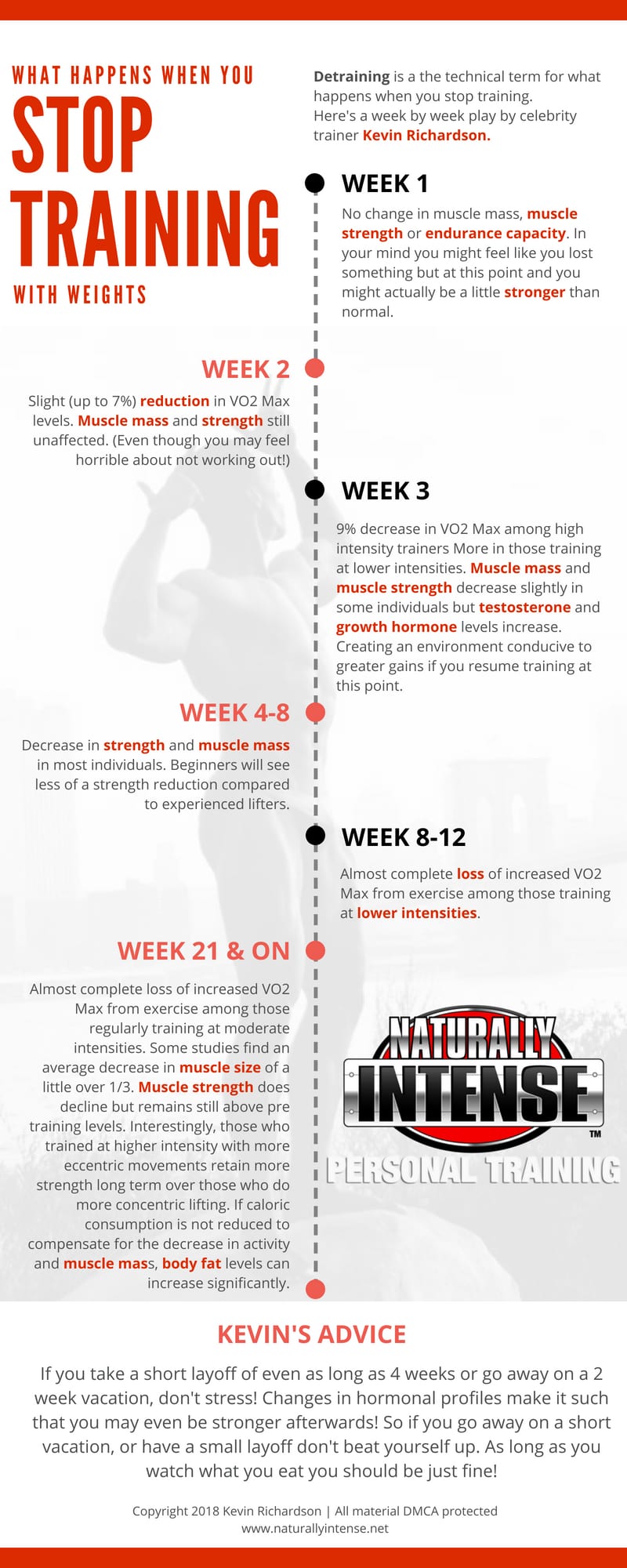
1 Week
No appreciable change in muscle mass, muscle strength and or endurance capacity. In your mind you might feel like you lost all your muscle and strength but it is really all in your head.
2 Weeks
Slight (up to 7%) reduction in VO2 Max levels, muscle mass and muscle strength still unaffected. (Even though you might feel horrible about not working out!)
3 Weeks
9% decrease in VO2 Max among those training at high intensities. Muscle mass and muscle strength beginning to decrease slightly in some individuals but testosterone and growth hormone levels increase creating an environment conducive to greater gains if you resume training at this point. But most athletes tend to have little noticeable reduction in strength and muscle mass after a layoff of 4 weeks. So if you go away on a short vacation, a layoff might even do you some good!
4-8 Weeks
Decrease in strength and muscle mass in most individuals with beginners seeing less of a strength reduction compared to experienced lifters.
8-12 Weeks
Almost complete loss of increased VO2 Max from exercise among those training at lower intensities.
21 Weeks and on
Almost complete loss of increased VO2 Max from exercise among those regularly training at moderate intensities. Some studies find an average decrease in muscle size of a little over 1/3. Muscle strength does decline but remains still above pre training levels. Interestingly, those who trained at higher intensity with more eccentric movements retain more strength long term over those who do more concentric lifting. If caloric consumption is not reduced to compensate for the decrease in activity and muscle mass, body fat levels can increase significantly.
What Happens When You Stop Training: Why Our Body Changes
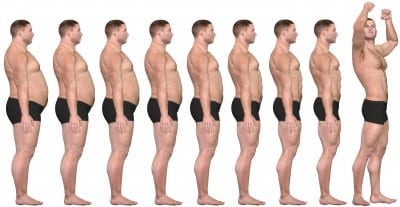
Detraining is the clinical term used to describe the effects on the body when regular training is ceased but before we delve into the details of detraining, we should first go over briefly why our muscles change in response to exercise in the first place. Muscle tissue is by nature completely adaptive, and is designed to cater to a wide variety of physical demands by changing its functional characteristics and or structural composition.[1,2,3,4] If you lift weights or have a job that requires heavy lifting on a regular basis to the point of overload, your muscles will respond by increasing the contractile proteins in a bid to increase it’s cross sectional area. In other words, your muscles will get bigger (and thus stronger) as a way of handling the very specific demands of your regular activity. (For a detailed review of the process read my article How Muscles Get Bigger & Stronger). Muscle fiber types change as well, as fast twitch muscle fibers- designed for brief but intense bouts of physical activity will become more predominant over time. Contrast this with an individual who does a lot of endurance work or whose daily activities involve a significant amount of steady state aerobic activity. In this case muscles will adapt by increasing capillary density and increasing oxidative slow twitch fibers to allow for more efficient performance over long periods of time. In both cases, if intensity levels are high enough, the heart (which by the way is a muscle) adapts as well. Cardiac capacity increases along with stroke volume and other adaptations in the body which all serve to increase peak aerobic capacity (VO2max). Allowing you to work harder longer. These adaptations to the stress of exercise and daily life have helped us survive the harsh and ever changing environment of our evolutionary past, and continue to help us today to be able to do the things we do.
In a way, you could say that our bodies are inherently lazy and try to use the least amount of energy possible to be able to meet the physical demands of our exercise routines and regular lives. Bigger, stronger muscles (fast twitch) makes it much easier to lift heavy objects and generate explosive power to do things like sprinting, jumping, kicking etc. whereas smaller more endurance based muscles (slow twitch) make it easier to run marathons, and do long distance type activities by making more efficient use of oxygen. These training induced adaptations are our body’s way of tolerating the rather specific demands of the exercises we do.[5,6,7,8,9] Keeping that in mind, there must be what is commonly referred to as a reversibility concept as removal of the activity that brought about change would lead to reversals in those very specific adaptations. The old adage, ‘Use it or lose it’ applies here fully as those reversals would over time lead to a decrease in athletic performance.[7,10,5,12,13,14] Sounds pretty obvious thus far, but the way our body adjusts to reduced workloads is not always as straightforward. How long you have been training, intensity levels, and training protocols all play a part in what happens when you stop.[16]
Thankfully some adaptations remain above levels of untrained sedentary individuals even after months of not working out, so you should always bear in mind that it is better to start and stop than it is to never start at all.
What Happens When You Stop Training: Changes In Muscle Fiber
Both muscle fiber size and type can change from extended time off from regular weight training.
The degree to which your muscle fibers are affected by detraining is directly proportional to the length of inactivity. As we mentioned earlier, muscle fibers change in response to the type of exercise stress placed upon them, but the good news is that short layoffs of up to 3 weeks seem to have little or no effect on overall distribution for both endurance and strength among well trained individuals.[9,15,17] Muscle size, however has been shown to change slightly after 3 weeks of inactivity.[9] One study found a 6.4% decline in mean fiber cross sectional area among weightlifters who stopped weight training over a 2 week period. Similar reductions were found in soccer players over a 3 week period as well, so at worst your muscles will get a little bit smaller when you stop training for a short time but it isn’t all bad news. Those same studies found that those very layoffs brought about an average increase in plasma concentrations of growth hormone of 58% and an elevation in testosterone levels by 19.2% in test subjects after a three week period of detraining. Testosterone/cortisol ratio levels were also increased by an average of 67.6%- an overall reduction of catabolic stress hormones and an increase in anabolic related hormones. An environment very much favorable to increased gains in strength, muscle mass, fat loss and overall performance.[17,18] It is a phenomenon quite well known to regular trainers who take a couple of weeks off here and there and feel much stronger when they resume weight training.
Among endurance trained athletes, muscle fiber changes are a bit different, as studies have generally found no decrease in muscle fiber cross sectional area after 14 days of detraining with size reductions occurring only after more time off from training. Some studies report a decrease in capillary density after 15 days of detraining, [9,19] while others have shown capillarization to remain mostly unchanged after 84 days of inactivity.[5] With regards to muscle capillaries there is an interesting and positive side effect to the reduced muscle size that happens long term when an endurance athlete stops training. Smaller muscles mean a reduction in the distance blood has to travel to deliver oxygen rich blood while working, which translates into an increase in athletic performance. It’s quite an amazing phenomenon that is most likely a hold over from our time as early humans. An evolutionary survival mechanism, if you will, that allowed our ancestors to maintain their much needed endurance capacity during periods of inactivity brought on by injury. In another interesting twist, long term layoffs among endurance trained athletes lasting over 4 weeks appear to bring about changes towards a greater percentage of fast twitch muscle fibers.[15,20,21] A study of long distance runners and cyclists reported a large progressive shift from FTa to FTb fibers in endurance runners and cyclists, the latter increasing from 5% in the trained state to 19% after 56 days of detraining
What Happens When You Stop Training: Muscle Fiber Changes Long Term
While short term layoffs can result in favorable outcomes, long term layoffs however do result in significant decline in muscle size. After 7 months of detraining, one study found an average atrophy of 37.1% for all types of muscle fiber in a power-lifter, along with (surprisingly) some fat weight loss as well. [24] A similar study of a high level bodybuilder reported a reduction of 9.3% of lean muscle mass after 15 months of not training, with consequent decreases in arm and leg size.[18] A decrease in fast twitch muscle fiber and a shift towards more oxidative slow twitch muscle fibers has been observed in some studies of strength and anaerobic type athletes after as little as two months of inactivity, however these reports are not conclusive as others have shown little or no changes after as long as 4-8 weeks.[22,23,25] During both short term and long term layoffs fast twitch muscle fibers appear to be most affected, which is significant as these are the fibers most responsible for the toned and tight look that most people seek. Fast twitch muscle fibers also are the ones that increase the most in terms of size and thus have the greatest effect on increasing the amount of calories burned daily and losing body fat over the long term. Women are particularly affected by detraining as they naturally have less muscle mass than their male counterparts and appear to lose muscle mass at a faster rate. A study of young female subjects engaged in a 7 week strength training program found that even though they were able to gain an average of an impressive 2 pounds of muscle, almost all the gains in lean tissue was gone after 7 weeks of not training.[27]
What Happens When You Stop Weight Training: Strength Changes
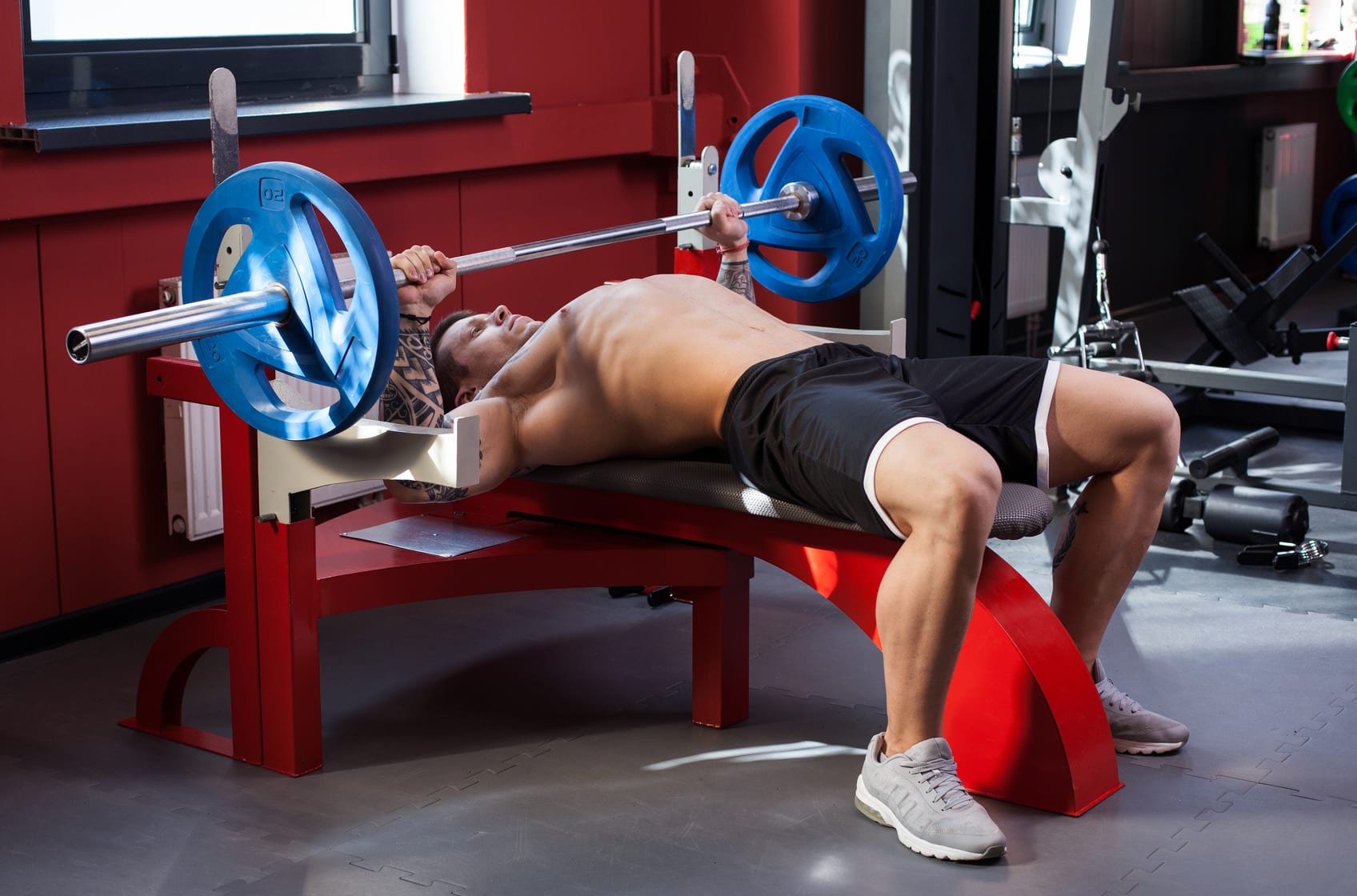
We have seen the somewhat mercurial nature of muscle fiber when training is stopped for significant periods of time, but what about strength? Most of us feel weaker with every passing day away from our regular workout routines, but for the most part an athlete can maintain most of their muscular strength during layoffs lasting no more than 4 weeks.[16] A study of weight lifters found that a two week period of detraining did not significantly change their one repetition maximum in the bench press and squat.[17] Isometric and isokinetic concentric force were also shown to be unaffected in the knee extension exercise and vertical jump.[17] A decline in eccentric strength (the ability to lower weight under control) was observed but all other aspects of neuromuscular performance were unaffected.[17]
Longer periods of inactivity however do result in more significant declines in strength performance among strength and sprint based athletes, however this loss is limited to only 7-12% during layoffs ranging from 8 to 12 weeks.[25] Both muscle atrophy and diminished neural muscle activation are largely responsible for these losses, as both fast twitch and slow twitch muscle fibers and maximal electrical activity in the muscles are reduced over a 12 week period of inactivity.[25,30,31] Some good news for beginners is that recently acquired strength gains isn’t lost as much when compared to seasoned athletes training consistently for longer periods of time.[32] Several studies found some strength loss after 4 to 8 weeks of inactivity after a 6-10 week high intensity training programs among those who were previously untrained. However, these losses none withstanding, they all maintained their muscular strength above pre-training levels.[32]
An interesting finding from detraining studies is that those who engaged in high intensity training protocols that emphasized the eccentric range of motion (lowering weight under control) lost strength over time at a much slower rate than those who trained in a more conventional manner using predominantly concentric lifts.[33,34] An discrepancy due to the fact that high intensity training protocols with eccentric movements produce greater gains than concentric only training.[34] Thus the inclusion of eccentric training is essential for those seeking greater and more long lasting neuromuscular strength adaptations. To summarize, if you are training at a high intensity, short layoffs from the gym won’t have much of an effect on your strength or muscle mass if you are away for a week or two and it takes about two to three months to really start seeing a decrease in strength and muscle mass.
What Happens When You Stop Training: Endurance & The Importance Of Intensity

While muscle mass and strength levels stay more or less the same for quite a while, one of the first things you will notice when you stop training is a decrease in your endurance. Running up the stairs or making a dash for the train may still be something that you can do, but you will soon feel a difference as you don’t seem to have the ‘wind’ that you used to, and you might have to stop and catch your breath a little more than you used to. Unlike strength losses, which are mostly psychological, endurance declines relatively quickly after training is stopped. One of the adaptations from intense exercise is a significant increase in aerobic capacity or peak oxygen uptake— commonly referred to as VO2 max. After a period of intense regular exercise this value goes up as your heart’s capacity to pump blood increases and the volume of blood sent out with each individual beat of the heart (cardiac output and heart stroke volume respectively).[19,26] This increased efficiency translates into a tangible boost in endurance— however in keeping with the reversibility concept, these increases deteriorate over time. A rapid average decline of 7% of peak oxygen uptake was observed in a study of experienced athletes who stopped training within 12 to 21 days, with a further drop in VO2 max values of 9% during the following 21- 84 days of inactivity.[11] The initial 7% decline during the first 12 days of inactivity was linked to a reduction in maximal heart stroke volume whereas the decrease in VO2 max during the 21-84 day period was associated with a decline in maximal arteriovenous oxygen, (which is the technical way of referring to the maximum amount of oxygen is present in your blood).
What is fascinating about the initial drop in VO2 max over the first few days of detraining is that while it is associated with reduced heart stroke volume, this drop in performance has little to do with any loss of cardiovascular function as it occurs because of a reduction in blood volume.[12] You might not be aware of it, but intense exercise usually results in an increase in blood volume by about 500ml from an expansion in plasma volume.[28,29] It’s an adaptation that occurs fairly quickly after only a few sessions of intense physical activity [28] and the increased blood volume means more oxygen rich blood is available to needy muscles when they are hard at work. The decrease in blood volume from detraining means your heart will (obviously) pump less blood with each stroke. However this isn’t a sign of any deterioration in cardiovascular ability as decreases in VO2 max and stroke volume are reversed when blood volume expands to pre-detraining values.[21] Consequently, individuals engaged in high intensity training for several years suffer little if any real reduction in heart function during short periods of inactivity.[21,33]
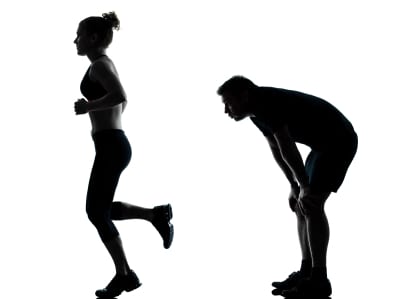
Intensity plays a major part in how much our exercise induced adaptations are reversed over time, both in terms of strength and endurance as the more intense your workouts were, the more you retain when you stop training, even for prolonged periods of time. Among those training at high intensities, studies show that levels of mitochondrial enzyme activity remains 50% higher than that of sedentary individuals, skeletal muscle capillarization is maintained at high levels and both VO2 max and maximal arteriovenous oxygen levels stabilize to a point 12-17% higher than untrained individuals even after 84 days of inactivity.[12] Detrained athletes who trained at high intensities also maintain higher exercise tolerance levels when compared to those who never exercised before. Not only do they have peak oxygen uptake levels significantly above untrained values but they also are able to exercise at a high percentage of their VO2 max before lactic acid accumulates in their blood.[12] Thus, they can do far more before becoming appreciably exhausted.[12] Among those engaging in regular low to moderate intensity exercise, the long term benefits are not as promising. A study of male subjects engaging in low intensity aerobic exercise for 20 minutes three times a week reported quite positive increases in VO2 max values of 6% to 8% above untrained levels after 7 weeks. However, these gains were completely reversed after 8 weeks of inactivity.
Moderate intensity exercise fares no better as even though such activity has been shown to increase VO2max by 10 to 20% or more, these values fall off rapidly during the first month of detraining and at a slower rate during the second and third month as they revert to pre-training levels.[35,36, 37] It is interesting to note that the very low to moderate intensity protocols used for the studies mimic universal recommendations for aerobic exercise, a form of training that research continues to show may not be the best option for those seeking long term health benefits.[cardio vs high intensity training] (See my article Rethinking The Need For Cardio)
What Happens When You Stop Weight Training: The Myth Of Muscles Turning To Fat

The commonly held notion is that when someone who is highly muscular stops training, their muscles eventually turn to fat. It’s a myth that has discouraged many from working out with weights for fear that if they stop, all their hard earned muscle mass will transform into gelatinous blobs of adipose tissue. The truth is, this is physically impossible as muscle and fat are completely different types of tissue and you can’t transform one into the other anymore than you can change lead into gold. Given the prevalence of this idea you might ask where this misunderstanding came from and it’s a prime example of the errors we can make based on our observations, since many of us personally know someone who was very big and muscular and now looks like all of his or her muscles have turned into fat. Here is what really happens─ let’s pretend for example that you are a very well-muscled 35 year old man weighing 200 lbs. (Ladies, bear with me on this one as it’s a bit easier to demonstrate what happens with a heavily muscled male since men increase body size to a higher degree than women do as a result of weight training.) So you are training very hard at the gym and because of your activity level and body size, you would need to eat 3,600 calories a day to maintain your bodyweight, which, as an aside, is why most bodybuilders and serious weight lifters eat as often as they do and is one of the greatest benefits to having a significant amount of lean muscle mass as you can eat more and still stay in great shape!
Now if you stopped training completely, as we mentioned earlier in the article, you will begin to lose muscle mass after several months without. How much muscle you lose would depends on several genetic and activity related factors, including how much muscle you gained to begin with, but since lean muscle tissue requires a significant amount of calories to maintain it, the amount of calories you would need to maintain your body weight will decrease. Also, since you will lose weight from the muscle being lost this will also mean that your energy requirements will be reduced and using some average numbers based on what I have seen over the years, a 200lb heavily muscled experienced trainer might lose anywhere from 10 to as much as 20 lbs if they stop training completely. If they were on steroids, the drop can be even more drastic as I have seen many professional bodybuilders lose as much as 50 lbs when they stop using steroids even though they kept on training. With such a reduction in body mass, your energy requirements would drop anywhere between 2,000 to 2,600 k/calories per day depending. That’s a huge decrease from a daily requirement of 3,600 k/calories and if you were used to eating that much for years on end, it would usually be very difficult to suddenly stop. In my experience, most former athletes keep eating pretty close to what they ate while they were actively training and more muscular, and consequently, they can easily gain significant amounts of body fat over time. This is especially true for older athletes, (see my article on How Weight Training Reverses The Aging Process). While on the outside it might look like the muscles are turning into fat, what you are really seeing is a slow reduction in muscle mass coinciding with a slow increase in body fat.
What Happens When You Stop Training: The Bottom Line

An important lesson we can take away from detraining is the importance of having a sustainable exercise program with some degree of high intensity training and eccentric movements. Many athletes, from bodybuilders, to dancers and fitness models tend to rely on excessive amounts of exercise and activity to keep their body fat levels down. This may work in the short term, but in the event of injury (which is often inevitable with extreme amounts of exercise) or simply life getting in the way of spending hours exercising; it will do more harm than good. The bottom line is that one day you will have to stop and when you do it will be very difficult to eat significantly less calories than you are accustomed to eating. Thus gaining weight is usually how the story ends. It makes sense then to always follow a workout program that you can reasonably follow long term, one that doesn’t call for hours upon hours of training that can increase your likelihood of sustaining a stress injury. (See my article on Exercise Addiction). Combine that with learning to eat well and you’ll have the best chances of getting into great shape and staying there. In the end, layoffs aren’t always a bad thing, so that vacation you took away from the gym for a couple of weeks shouldn’t leave you miserable and depressed. A layoff can mean greater gains down the road and even if you are forced to stop for a significant amount of time, keep in mind that any losses in strength, conditioning and or muscle mass will be quickly reversed when you resume training.
High Intensity Bodyweight Training: Ballistic Pushups & Dips!
This was a tough one!
Starts out with ballistic push ups (like clap pushups but without the clap as my wrist is still not 100%) nonstop for 20 reps, then all out on dips for 10 reps.
To say it was painful would be an understatement, but you just have to push through and keep on going.
Still training, hope you are too and as always, Excelsior!!! #naturallyintense
#hometraining #homeworkout #homeworkout #highintensitytraining #naturalbodybuilder #naturalbodybuilding #fitover40 #naturalbodybuildingvideos #chestday #chesttraining #naturalbodybuildingtips #pushups #dips #bodyweighttraining #highintensitytrainingtips #drugfreebodybuilding #calesthenics
Kevin's Unconventional Biceps Training- 3-6 Minutes a Week!
In this video I go over my biceps training using the Naturally Intense High Intensity Training protocols that helped me go from having arms measuring 11.5 to 12 inches to 18 inches drug free!
It's an unconventional approach for certain, but it's one that's helped my arms grow and the hundreds of men and women I have trained over the past 30 plus years.
Now, my success isn't due to being genetically gifted, as it took me the better part of 11 years to get my arms up to those measurements.
Which is significant as it works and been been proven time and time again to work for the average man or woman trying to grow their arms without drugs.
It's my hope that these high intensity training protocols can help you as much as they helped me!
Click on my bio link to see the full video on my YouTube channel and thanks as always for taking the time to look at my work!!! Excelsior!!! #naturallyintense
#highintensitytraining #naturalbodybuilder #naturalbodybuilding #fitover40 #naturalbodybuildingvideos #armworkout #bicepsworkout #naturalbodybuildingtips #biceps #armtraining #highintensitytrainingtips #drugfreebodybuilding #barbellcurls
At the Lancaster Classic Day 2 Elimination Rounds Against European Champion, and World Record Holder Leo Pettersen @leo_barebow_archer
I don't talk much about it but I'm also a competitive barebow archer (surprise!) and last Saturday I had the honor of making it to Day 2 at the Lancaster Archery Classic in the Barebow Division, as I made the top 64 out of 267 competitors and had a chance to shoot with some of the greatest barebow shooters on the planet!
I didn't make it past Leo, but it was a real rush to be there and a huge thanks to my coach, Joe MyGlyn @prolinearchery for helping me get there.
Thanks as well to my good friend @sean_chan33 for all of his help from the very start, to my line buddy Aaron Shea for taking the shot and showing up to support!
My thanks as well to rob_kaufhold for putting on and promoting one of the best archery tournaments on earth!
Thanks also to to everyone who took the time to send a supporting word and I am looking forward to next year!!! #naturallyintense #barebow
#lancasterclassic #lancasterarcheryclassic2024 #lancasterarchery #archery #fitover40 #barebowrecurve #targetarchery
Dumbo, Brooklyn circa 2004
This shot was taken as part of the promotion for my Naturally Intense DVD and was about a year after my last bodybuilding competition.
It was a grueling photoshoot.
We started at about 10 am and finished around 4pm and I was completely spent, but the more we shot the sharper I looked, so we kept on going.
It's nice to look back from time to time and as tired as I was, we all had a blast!
My thanks to @stephanie_corne_artwork, @https://pulse.ly/itgnag2dec and @ftaz1 for taking the shots!!!
Thanks for watching and as always, Excelsior!!! #naturallyintense
#naturalbodybuilder #naturalbodybuilding #throwback #fifthavenuegym #5thavenuegym #drugfreebodybuilding #naturalbodybuildinglifestyle #gymlife #gymmotivation #naturalbodybuildingmotivation #bodybuilding #blackandwhite #instablackandwhite #bnw
Can You Build An Impressive Physique Training Only At Home?
Absolutely!
I stopped training in commercial gyms as of March 2020 and have been training at home ever since.
Initially I was admittedly worried that I might lose some of my gains or not make as much progress, but that certainly wasn't the case.
I've consistently continued to improve with my high intensity workouts and muscles have no idea where they are training.
As long as the criteria of adequate intensity and overload are met, there will be an adaptive response and your muscles will get bigger and stronger.
So don't worry at all about where you train, focus instead of what will be the best way for you to always be training!
Thanks for watching and as always, Excelsior!!! #naturallyintense
Kevin's Three Day Training Spilt!
For the past 33 years I have trained three times a week with Naturally Intense High Intensity Training workouts lasting 10, 15 to 20 minutes max.
It's a training split tried and testes not only in it's helping me realize my goal of becoming a successful natural bodybuilder, but it's also helped hundreds of men and women over the past three decades.
I have tested just about every possible training split imaginable and for this particular style of high intensity training, this particular grouping consistently yields fantastic results.
I hope it helps you as much as it's helped me over the years and thanks so much for taking the time to look at my work.
Keep training hard and Excelsior!!! #naturallyintense
Excelsior!!! #naturallyintense
#trainingsplit #3daytrainingsplit #threedaytrainingsplit #naturalbodybuilding #naturalbodybuilder #naturalbodybuildingvideo #naturalbodybuildingmotivation #naturalbodybuildingtips #drugfreebodybuilding #bodybuilding #highintensitytraining #highintensitytrainingtips
405 Stiff Leg Deadlift for 7 Reps! High Intensity Training.
First leg workout of the year and already pushing it!
I haven't done a stiff leg deadlift over 315lbs for about 3 years at this point, and I did my last set with 315lbs and comfortably got to 10 reps and decided I had far too much gas left in the tank and that I should go up in weight.
So I did.
I figured I might get a solid 6 reps in, but I made it to 7 and I think I could have gone on to get a full 10 reps BUT that's when good judgement prevailed.
As a bodybuilder having not trained this heavy for so many years, the shock of this much weight would be more than enough to stimulate muscle growth, and doing more reps wouldn't yield any greater returns, only increase the likelihood of injury.
It's not about the numbers, it's about training to a point where you achieve your goal, and it's important to have a goal in mind as a bodybuilder based on increasing muscle mass rather than hitting a particular number.
Besides, if in my 20's I never did more than 405lbs on a stiff leg deadlift, it doesn't make any sense going heavier than when I am almost 50!
Could I deadlift more at this point?
Absolutely but just because you can doesn't mean you should!
So keep those weights in a good working range, keep it safe and as always Excelsior!!! #naturallyintense
#hometraining #homeworkout #homeworkout #roguerack #highintensitytraining #naturalbodybuilder #naturalbodybuilding #fitover40 #naturalbodybuildingvideos #backworkout #naturalbodybuildingtips #backtraining #highintensitytrainingtips #drugfreebodybuilding #fitoverforty #deadlift
Turning 50 in a few months...
Not much of a big deal for me as I still feel pretty much the same but I hope that my example helps show what can be done with a lifetime commitment to eating well and training consistently!
Thanks for coming along on the journey and as always, Excelsior!!! #naturallyintense
#naturalbodybuilder #naturalbodybuilding #healthylifestyle #fitover40 #drugfreebodybuilding #naturalbodybuildingmotivation #natty #fitness
Please note that all material is copyrighted and DMCA Protected and can be reprinted only with the expressed authorization of the author.
No Time To Train? Click To Get Celebrity Trainer Kevin Richardson’s Ebook!
Featured everywhere from the Wall Street Journal to CBS News, Kevin Richardson’s Naturally Intense High Intensity Training have helped hundreds lose weight and transform their bodies with his 10 Minute Workouts. One of the top natural bodybuilders of his time, Kevin is also the international fitness consultant for UNICEF and one of the best personal trainers in New York City. Learn more about his award winning NYC personal training services here!
Related Articles:
Why People Store Fat In Different Parts Of The Body
References For What Happens When You Stop Training:
- Gordon T, Patttullo MC. Plasticity of muscle fiber and and motor unit types. Exerc. Sports Rev 1993
- Hoppeler H Exercise induced ultrastructrual changes in skeletal muscle. Int. J. SportsMed 1986
- Neufer PD, Costilli DL, Fielding RA, Flynn MG, Kirwan JP. Effect of reduced training on muscular strength and endurance in competitive swimmers. Eur. J. Appl. Physiol. 1989
- Saltin B, Gollnick PD. Skeltal muscle adaptabilty significance for metabolism and performance. Handbook of Physiology: Skeletal Muscle, American Physiological Society 1983
- Coyle, E. F. Detraining and retention of training-induced adaptations. In: Resource Manual for Guidelines for Exercise Testing and Prescription, S. N. Blair, et al. (Eds.). Philadelphia: Lea & Febiger, 1988
- Gollnick, P. D., Moore, RL, Reidy M, Quintinskie JJ. Significance of skeletal muscle oxidative enzyme changes with endurance training and detraining. Med. Sport Sci. 1984.
- Houston, M. E. Adaptations in skeletal muscle to training and detraining: the role of protein synthesis and degradation. In: Biochemistry of Exercise VI, B. Saltin (Ed.). Champaign, IL: Human Kinetics, 1986
- Tidow, G. Muscular adaptations induced by training and detraining. A review of biopsy studies. New Studies in Athletics 1995.
- Bangsbo, J, Mizuno M. Morphological and metabolic alterations n soccer players with detraining and retraining and their relation to performance. In: Science and Football: Proceedings of the First World Congress of Science and Football, Liverpool, England, 1987
- Costill, D. L. Detraining: loss of muscular strength and power. Sports Med. Digest 1988.
- Coyle EF. et al Time course adaptations after stopping prolonged intense endurance training. J. Appl Physiol, 1984
- Coyle, E. F. Detraining and retention of training-induced adaptations. Sports Sci. Exchange 1990.
- Fleck S. J. Detraining: its effects on endurance and strength. Strength Cond. 1994.
- Hawley, J. A. Physiological responses to detraining in endurance trained subjects. Aust. J. Sci. Med. Sport. 1987.
- Houston, ME, Bentzen H, Larsen H. Interrelationships between skeletal muscle adaptations and performance as studied by detraining and retraining. Acta Physiol. Scand. ,1979.
- Mujika I, Padilla S. Muscular characteristics of detraining in humans. Med & Sci in Sports & Exerc. 2001
- Hortob’Agyi T, Houmard JA, Stevenson JR, Fraser DD, Johns RA, Israel RG. The effects of detraining on power athletes. Med. Sci. Sports Exerc. 1993.
- Houmard JA, Hortob’Agyi T, Neufer PD et al. Training cessation does not alter GLUT-4 protein levels in human skeletal muscle. J. Appl. Physiol. 1993.
- Blomquist CG, Saltin B. Cardiovascular adaptations to physical training. Annu Rev Physiol 1983
- Houmard J. A., Hortob’Agyi T, Johns RA, et al. Effect of short-term training cessation on performance measures in distance runners. Int. J. Sports Med. 1992.
- Coyle EF, Martin WH 3rd, Bloomfield SA, Lowry OH, Holloszy JO. Effects of detraining on responses to submaximal exercise. J. Appl. Physiol. 59:853– 859, 1985
- Ha¨kkinen K, Ale’n M. Physiological performance, serum hormones, enzymes and lipids of an elite power athlete during training with and without androgens and during prolonged detraining: a case study. J. Sports Med. 1986.
- Amigó N, Cadefau JA, Ferrer I, Tarrados N, Cussó R. Effect of summer intermission on skeletal muscle of adolescent soccer players. J. Sports Med. Phys. Fitness 1998.
- Staron RS, Hagerman FC, Hikida RS. The effects of detraining on an elite power lifter: a case study. J. Neurol. Sci. 1981.
- Hakkinen K., Komi PV, Tesch PA. Effect of combined concentric and eccentric strength training and detraining on forcetime, muscle fiber and metabolic characteristics of leg extensor muscles. Scand. J. Sports Sci. 1981.
- Rowell LB, Human cardiovascular adjustments to exercise and thermal stress. Physiol Rev 1974
- Smith DP, Stransky FW. The effect of training and detraining on the body composition and cardiovascular response of young women to exercise. J. Sports Med. 1976.
- Green HJ, et al. Alterations in blood volume following short term supramaximal exercise. J. Appl Physiol 1984
- Chi MM-Y, et al. Effects of detraining on enzymes of energy metabolism in individual human muscle fibers. Am J Physiol 1983
- Ha’kkinen K, Komi PV. Electromyographic changes during strength training and detraining. Med. Sci. Sports Exerc. 1983.
- Ha’kkinen K, Ale’n M, Komi PV. Changes in isometric force- and relaxation-time, electromyographic and muscle fibre characteristics of human skeletal muscle during strength training and detraining. Acta Physiol. Scand. 1985.
- Shaver LG. Cross-transfer effects of conditioning and deconditioning on muscular strength. Ergonomics 1975.
- Colliander EB, Tesch PA. Effects of detraining following short term resistance training on eccentric and concentric muscle strength. Acta Physiol. Scand. 1992
- Housh TJ, Housh DJ, Weir JP, Weir LL. Effects of eccentric-only resistance training and detraining. Int. J. Sports Med. 1996.
- Convertino V, Hunh J, Goldwater D, DeBusk R. Cardiovasular responses to exercise in middle aged men after 10 days of bedrest. Circulation 1982
36.Fox et al. Frequency and duration of interval training programs and changes in aerobic power. J Appl Physiol 1975
37. Klausen K, AndersenLB, Pelle I. Adaptive changes in work capacity, skeletal muscle capillarization and enzyme levels during training and detraining. Acta Physiol Scand 1981
38. Drinwater BH, Horvath SM. Detraining effects on young women. Med Sci Sports Exerc 1972
